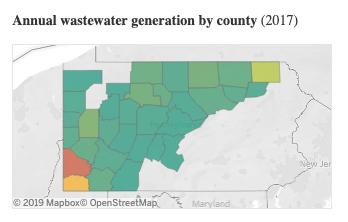Comprehensive study tracking 26 years of waste disposal shows most stays in-state

Credit: PSE Healthy Energy
OAKLAND, Calif. – More than 80 percent of all waste from Pennsylvania’s oil and gas drilling operations stays inside the state, according to a new study that tracks the disposal locations of liquid and solid waste from these operations across 26 years. Numerous human health hazards have been associated with waste from oil and gas extraction, including potential exposure to compounds known to cause cancer.
The study is the first comprehensive assessment of Pennsylvania’s waste-disposal practices, tracking from 1991 – when the state began collecting waste-disposal information – through 2017. In southwestern Pennsylvania, most solid waste goes to landfills in the county where it was produced, the study also found, while in northern counties along state borders, solid waste generally moves to neighboring states of Ohio and New York.
“Tracking waste across space – the distance and direction it travels and where it ends up – and across time helps us determine who is absorbing the potential health burdens associated with these waste products, both from recent operations and from legacy pollution across the lifetime of the state’s oil and gas operations,” said Lee Ann Hill, a researcher at Physicians, Scientists and Engineers for Healthy Energy (PSE) and lead author of the study, which was published in Science of the Total Environment on April 22.
Use the interactive data tool to explore the study’s findings in a visual format.
Oil and gas development produces high-salinity water that can contain strontium and radium – substances classified as known human carcinogens. Solid waste includes cuttings from drilling that can bring naturally occurring radioactive materials including uranium, radium, and thorium, up from the subsurface to the surface, creating the potential for human and environmental exposures to these toxic compounds.
Previous studies have tracked only subsets of oil and gas waste-disposal data. For example, many past studies have focused just on waste from high-volume hydraulic fracturing, the process used at scale since 2008 to extract oil and gas from Pennsylvania’s Marcellus Shale formation. But the PSE-led study also tracks waste from conventional oil and gas development, which has taken place in Pennsylvania since records have been kept and continues today. Conventional drilling operations accounted for nearly one third of all waste, the data showed.
“We know that many of the hazards and risks associated with waste from oil and gas extraction exist for both conventional and unconventional operations,” Hill said. Yet, researchers note, legislation passed in 2016 strengthened disposal location tracking for unconventional oil and gas operations, but similar reporting practices were not required for conventional operations. “From a public health perspective, it doesn’t really make sense that conventional operators are held to a different standard,” she says.
Where does it go?
Solid waste mainly goes into landfills. Some of the state’s liquid waste – 7.6 percent, or 30 million barrels over the study’s time period – is sent to municipal or other water treatment plants, which discharge into surface waters like rivers after limited treatment. Studies have shown that despite treatment operations, pollution remains in sediment downstream from release sites. For example, radium persists in sediment for many years and strontium, which accumulates in bones of living things, much like calcium, has been found in the shells of riverbed mussels downstream of treatment facilities.
More than half of the liquid waste that remains in Pennsylvania was reused in extraction operations, the study found, a practice that can result in more concentrated levels of salinity and chemical residues with each subsequent use. Researchers note that the pervasiveness of this practice raises questions about how to treat or dispose of these more concentrated waste streams in the future, when drilling operations slow or cease, diminishing the demand for wastewater reuse.
For more than a third of liquid waste from all oil and gas operations – 35 percent – the final location is unknown, often because reporting reflects only intermediary locations for transfer or storage. “This finding illuminates what we don’t know,” Hill said.
The study concludes that a uniform cradle-to-grave reporting system should be put in place to properly assess hazards and risks to human health and the environment posed by waste streams from all types of oil and gas production. “Understanding where and when waste enters our environment helps scientists and communities quantify human exposures to these contaminants and measure environmental impacts,” she said.
###
Dominic DiGiulio, Seth B.C. Shonkoff, and Eliza Czolowski, all of PSE, co-authored the study, titled Temporal and Spatial Trends of Conventional and Unconventional Oil and Gas Waste Management in Pennsylvania, 1991 – 2017.
Read the study.
View the interactive visualizations.
Physicians, Scientists and Engineers (PSE) for Healthy Energy is a nonprofit research institute dedicated to supplying evidence-based scientific and technical information on the public health, environmental and climate dimensions of energy production and use. We are the only interdisciplinary collaboration focused specifically on health and sustainability at the intersection of energy science and policy. Visit us at psehealthyenergy.org and follow us on Twitter @PhySciEng.
Media Contact
Alex Abu-Hakima
[email protected]




